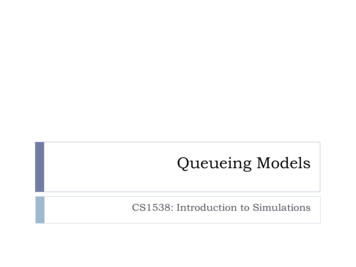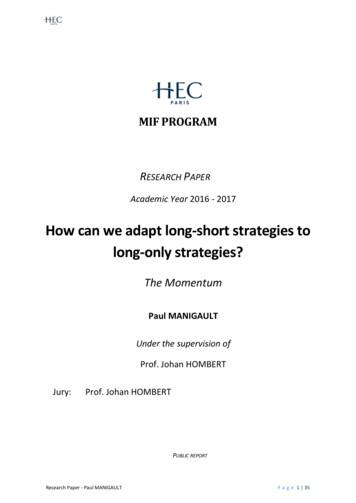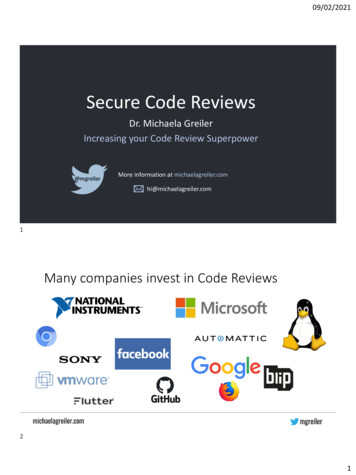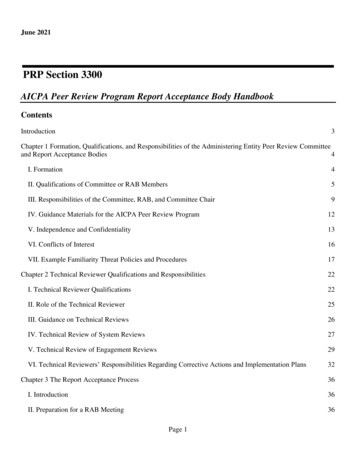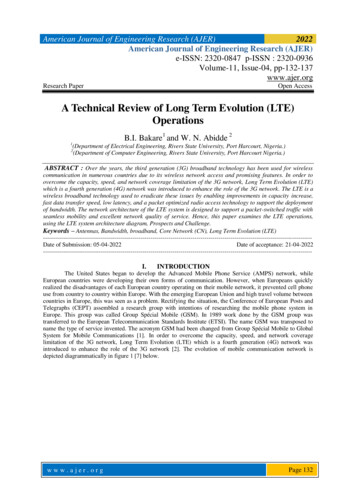
Transcription
American Journal of Engineering Research (AJER)2022American Journal of Engineering Research (AJER)e-ISSN: 2320-0847 p-ISSN : 2320-0936Volume-11, Issue-04, pp-132-137www.ajer.orgResearch PaperOpen AccessA Technical Review of Long Term Evolution (LTE)OperationsB.I. Bakare1 and W. N. Abidde 21(Department of Electrical Engineering, Rivers State University, Port Harcourt, Nigeria.)(Department of Computer Engineering, Rivers State University, Port Harcourt Nigeria.)2ABSTRACT : Over the years, the third generation (3G) broadband technology has been used for wirelesscommunication in numerous countries due to its wireless network access and promising features. In order toovercome the capacity, speed, and network coverage limitation of the 3G network, Long Term Evolution (LTE)which is a fourth generation (4G) network was introduced to enhance the role of the 3G network. The LTE is awireless broadband technology used to eradicate these issues by enabling improvements in capacity increase,fast data transfer speed, low latency, and a packet optimized radio access technology to support the deploymentof bandwidth. The network architecture of the LTE system is designed to support a packet-switched traffic withseamless mobility and excellent network quality of service. Hence, this paper examines the LTE operations,using the LTE system architecture diagram, Prospects and Challenge.Keywords – Antennas, Bandwidth, broadband, Core Network (CN), Long Term Evolution ---------------------------------------Date of Submission: 05-04-2022Date of acceptance: ODUCTIONThe United States began to develop the Advanced Mobile Phone Service (AMPS) network, whileEuropean countries were developing their own forms of communication. However, when Europeans quicklyrealized the disadvantages of each European country operating on their mobile network, it prevented cell phoneuse from country to country within Europe. With the emerging European Union and high travel volume betweencountries in Europe, this was seen as a problem. Rectifying the situation, the Conference of European Posts andTelegraphs (CEPT) assembled a research group with intentions of researching the mobile phone system inEurope. This group was called Group Spécial Mobile (GSM). In 1989 work done by the GSM group wastransferred to the European Telecommunication Standards Institute (ETSI). The name GSM was transposed toname the type of service invented. The acronym GSM had been changed from Group Spécial Mobile to GlobalSystem for Mobile Communications [1]. In order to overcome the capacity, speed, and network coveragelimitation of the 3G network, Long Term Evolution (LTE) which is a fourth generation (4G) network wasintroduced to enhance the role of the 3G network [2]. The evolution of mobile communication network isdepicted diagrammatically in figure 1 [7] below.www.ajer.orgwww.ajer.orgPage 132
American Journal of Engineering Research (AJER)2022Fig 1. Evolution of Mobile Communication NetworkLTE has become the most successful wireless broadband technology, providing wireless service toover one billion users as of the beginning of 2016 and handling a wide range of applications. LTE has greatlyevolved from the analog voice-only service it rendered over 25 years ago, to the current stage of development ofthe fourth generation, and heading towards the fifth generation of mobile broadband technology [3]. LTE hasrevolutionized our communication services by ensuring telephony and internet access availability from almosteverywhere and anytime with extremely fast data speeds for uploads and downloads. LTE enables voice calls,data services, video calls and multimedia applications [10]LTE uses Orthogonal Frequency Division Multiple Access (OFDMA) for system improvement, suchas; improved capacity and coverage, improved end-user throughputs, improved user experience with fullmobility, reduced operation cost, flexible bandwidth operation and seamless integration with existing systems[10]. LTE uses an Internet Protocol based core network to achieve a successful network service. Quality ofservice operations are made standard on all interfaces for the purpose of ensuring that the prerequisite of voicecalls for delay reduction and improved bandwidth can be sufficiently met when capacity limits have beenattained. LTE system provides a peak data rate of 100Mbps in the downlink and 50 Mbps in the uplink [5]. 4Galso known as IMT-Advanced was first launched in 2010 to implement the only packet-switching technique. Itis integrated with one Core Network and several Radio Access Networks (RANs) and provides a complete IPbased network of 100 Mbps to 1 Gbps speed with a frequency of 2–8 GHz. Since the range of coverage wassmaller due to high speed, it became necessary to incorporate multiple smart antennas to support long-rangecommunication. Good Quality of Service (QoS) and data rates in 4G support services with better clarity; suchservices include but are not limited to Mobile Television, High Definition Television (HDTV) content, DigitalVideo Broadcasting (DVB), Video Chat, Multimedia Newspapers, and High-Quality Live streaming. 4G offersultra-low latency compared to 3G. Long Term Evolution (LTE) and WiMAX (World Wide Interoperability forMicrowave Access) are the dominant technologies employed by 4G. While LTE offers downlink data rates of100 Mbps and uplink of 50 Mbps, WiMAX on the other hand allows downlink data rates of 75 Mbps and uplinkof 25 Mbps [12]II.LTE ADVANCED (LTE-A)The LTE Advanced is a mobile communication technology, which is a major enhancement of the LongTerm Evolution technology. LTE is often times called 4G whereas the LTE Advanced is the true step toward thefuture of LTE [6]. LTE Advanced is compatible with the initial LTE technology. LTE Advanced engaged agood number of techniques that aided better performance and higher data rates, particularly at cell edges andother areas where performance would not usually have been great [6].LTE and LTE Advanced make use of multiple input multiple output (MIMO) which enables data ratesto be increased to a great length. MIMO is a type of antenna technology which makes use of multiple antennasto allow signals travelling through different paths to be unconnected, thus, their capacity is used to enhance thedata throughput and/or the signal to noise ratio, which ultimately improves the system performance [5].Key features of LTE Advanced include: Spectrum efficiency which is three (3) times greater than LTE.www.ajer.orgwww.ajer.orgPage 133
American Journal of Engineering Research (AJER) 2022Peak data rates of 1Gbps in the downlink and 500Mbps in the uplink.Peak spectrum efficiency of 30bps/Hz in the downlink and 15bps/Hz in the uplink.Spectrum use: scalable bandwidth use and spectrum aggregation are both supported.Low Latency: From idle time to connected in less than 50ms and then shorter than 5ms one way or forindividual packet transmission.Cell edge user throughput is two (2) times that of LTE.Average user throughput time is three (3) times that of LTE.Mobility is the same as that of LTE.Compatibility state between LTE-A and LTE is very good [4]III.LTE NETWORK PRINCIPLE OF OPERATIONSThe main components of the LTE network architecture are the User Equipment (UE), the Evolved UMTSterrestrial radio access network (E-UTRAN), and the Evolved Packet Core (EPC).The EPC key components include: The Mobility Management Entity (MME): This handles the session states and ensures authenticationof a user as well as tracking a user across the network. Serving Gateway (S-Gateway): This routes data packets through the access network. Packet Data Node Gateway (PGW): This acts as the interface between the LTE network and otherpacket data networks [2].These are all shown in fig. 2 [2] below.Figure 2: LTE Network ArchitectureLTE UEs are also known as Mobile stations (MS) or LTE data terminals or devices that are of standardto access the internet via 4G LTE network, such as the mobile phones, smart TVs, WiFi devices, tablets etc.LTE E-UTRAN consists mainly of the eNodeB (eNB), providing air interface for data traffic to and fro userequipment, eNodeB does several important functions such as Radio Resource Management (RRM), radio bearercontrol, radio admission control, mobility connection control, radio resource scheduling , packet compressionand ciphering, routing of User Plane Data towards S-GW (Serving Gateway), packet scheduling andtransmission of broadcast information and paging messages, measurement, reporting, configuration andreconfiguration of E-UTRAN parameters, load control, admission control etc [13]. The eNode-Bs consist ofthree major elements: The antennas, which are the most visible parts of a mobile network; Radio modules thatmodulate and demodulate all signals transmitted or received on the air interface; Digital modules that process allsignals transmitted and received on the air interface and that act as an interface to the core network over ahigh‐ speed backhaul connection.The general LTE network architecture has two parts, which are; radio network part and a corenetwork part [4]. One of the complex mechanisms in the LTE network is the radio base station, referred to aseNode‐ B. The name is obtained originally from the UMTS base station (Node‐ B) with an ‘e’ referring to‘evolved’ [6]. The UMTS radio network is referred to as the UTRAN (Universal Mobile TelecommunicationsSystem Terrestrial Radio Access Network), while the LTE radio network is referred to as the E‐ UTRAN [4].The eNode‐ Bs consist of three major elements:1. The antennas. They are the most visible parts of a mobile network;www.ajer.orgwww.ajer.orgPage 134
American Journal of Engineering Research (AJER)20222. Radio modules. These modulate and demodulate all signals being transmitted or received on the airinterface;3. Digital modules. They process all signals transmitted and received on the air interface which interface withthe core network over a high‐ speed backhaul connection [3].This means that the eNode‐ B is responsible for air interface as well as the following outlined below: Air interface resources and user management is scheduled efficiently; QoS management, such as; enabling latency and minimum bandwidth requirements for real‐ timebearers and maximum throughput for background applications based on user profile; Load is balanced between various simultaneous radio bearers to different users; Mobility management; Interference management, which means, minimizing the effect of its downlink transmissions onsurrounding base stations in cell‐ edge scenarios [2].The physical routing of the S1 and the X2 interface is depicted below in fig. 3 [2].Fig. 3 Physical Routing of the S1 and the X2 InterfaceThe SI interface is the interface between the core network and the base station. Similar to the S1interface, the X2 interface is self-reliant, while IP is used on layer 3. The X2 interface connects base stationsdirectly with each other [6]. The network node tasked with signaling exchanges between the base stations andthe core network between users is the Mobility Management Entity (MME). The MME is responsible forauthentication, establishment of bearers, NAS mobility management, handover support, interworking with otherradio networks, SMS and voice support [4].The S‐ GW handles management of user data tunnels between the eNode‐ Bs in the radio networkand the Packet Data Network Gateway (PDN‐ GW), which is the gateway router to the Internet. Single user S1and S5 tunnels are not dependent on one another and can be changed [3]. The PDN‐ GW equally assigns IPaddresses to mobile devices. The HLR and the HSS are joined to ensure seamless roaming between the variousradio access networks [2]. There are some very essential user parameters in the HSS and they are: The user’s International Mobile Subscriber Identity (IMSI), which uniquely identifies a subscriber. Authentication information which is used to authenticate the subscriber and generate encryption keys on asession basis; Circuit‐ switched service properties, such as; the user’s telephone number, referred to as the MobileSubscriber Integrated Services Digital Network (MSISDN) number. A copy of the IMSI is stored on the subscriber identity module (SIM) card of the subscriber; Packet‐ switched service properties such as the Access Point Names (APNs) the subscriber is allowed touse. IMS‐ specific information the ID of the current serving MSC so that incoming circuit‐ switched calls and SMS messages can be routedcorrectly; The ID of the SGSN or MME, is used in the event that the user’s HSS profile is updated, so as to move thechanges to the network elements.The basic architecture of LTE contains a separate IP connectivity layer for all the IP based services andevolved packet system (EPS) which handles the overall communication procedure.www.ajer.orgwww.ajer.orgPage 135
American Journal of Engineering Research (AJER)2022Fig. 4 Interconnection of LTE to GSM and UMTS NetworksThere has to be a connection between the LTE network, GSM and UMTS networks to ensure that thesubscriber’s context, which is; the assigned IP address, quality of service settings, authentication and cipheringkeys, etc., can be exchanged in a seamless way between all the core network components. This is depicted infig. 4 [2].The basic principles for LTE include:o A packet-based architecture where events in real-time can take place.o Reduction in number of interfaces.o Reduction of delay variation for traffic which needs low delay jitter.o An end-to-end quality of service to manage the different types of traffic.o An enhanced user experience focusing on more services with reduced cost and high speed [14].IV.ADVANTAGES AND DISDVANTAGES OF LTE SYSTEMSTable 1.0 [11] summarizes the advantages of the LTE system and the disadvantages of the LTE system.It shows that the advantages of the LTE system surpass the disadvantages of the LTE system. This essentiallymeans that the LTE system is more of an advantage to be in existence than a disadvantage.Table 1.0 Advantages and Disadvantages of the LTE SystemS/N1AdvantagesHigher bandwidth (faster data transfer speed)2Lower Latency (faster response time)3Improved spectrum efficiency (increase in overallnetwork capacity)High security wireless cellular network45678910Highly reliable when a good LTE signal isavailableData and voice exchange between participantsdue to packet switchingTransfer of high amount of data between thesender and receiverAll data consumption occurs to low powerconsumption leading to longer and better lifespanof smart phone batteriesHigh speed of file uploads and downloadsHigher versions of LTE such as; LTE Advanced(LTE-A) will further improve the performance ofexisting LTE standard based products.www.ajer.orgwww.ajer.orgDisadvantagesLTE is not currently available in all cities in countries all overthe world.LTE is a complex system that requires only skilled people tomaintain and manage the system.More towers and new technologies need to be developed forbetter signals while in transit, for instance; in buses and trains.LTE technology cannot be used in old versions of smartphones. It requires smart mobile phones which support LTEfunctionality.Purchase of new current version of smart phones for the solepurpose of making use of the LTE system is a costly affair.It requires smart mobile phones which support LTEfunctionalityMore towers and new technologies need to be developed forbetter signalsPurchase of new current version of smart phones for the solepurpose of making use of the LTE system is a costly affairMore towers and new technologies need to be developed forbetter signalsMore towers and new technologies need to be deployedPage 136
American Journal of Engineering Research (AJER)V.2022CONCLUSIONLTE has become the most successful mobile wireless broadband technology, with the fifth generationalready in place and the sixth generation in the beginning stages. Currently, there are over 5 billion 4G LTE andover 300 million 5G subscriptions globally. The LTE wireless technology have evolved from the voice-only 1Gto 6G having voice, SMS, data, video, etc., capacities currently. The LTE Advanced is a major enhancement ofLTE technology. This is a massive evolution, which is still on-going by the day. Within the next 5 years, weexpect LTE to be even more successful than it already is today. We expect LTE to be available in all cities incountries all over the world, to have more towers and new technologies for better signals while in transit, forinstance; in buses and trains, to be able to provide faster data transfer speed, faster response time, and moreincrease in overall network [11][12][13]B.I. Bakare, I.A. Ekanem and I.O Allen. Appraisal of Global System for Mobile Communication (GSM) in Nigeria, AmericanJournal of Engineering Research (AJER) e-ISSN: 2320-0847 P-ISSN: 2320-0936.Vol-6, Issue-6, pp-97-102, 2017.M. Sauter, From GSM to LTE – Advanced Pro and 5G: An Introduction to Mobile Networks and Mobile Broadband, (PeriodicalStyle— accepted for publication), 3rd Ed., John Wiley & Sons ltd., Ed. West Sussex, United Kingdom: John Wiley & Sons ltd,2017, pp. 211–330.A. Kukushkin, Introduction to Mobile Network Engineering: GSM, 3G-WCDMA, LTE and the road to 5G, John Wiley & Sons ltd.,Ed. West Sussex, United Kingdom: John Wiley & Sons ltd, 2018, pp. 205–374C. Cox, An Introduction to LTE: LTE, LTE-Advanced, SAE, VoLTE and 4G Mobile Communications, (Periodical Style—Accepted for publication), 2nd ed., John Wiley & Sons ltd., Ed. West Sussex, United Kingdom: John Wiley & Sons ltd, 196 5, pp.1–161.E. Dahlman., S. Parkvall., J. Skold, 4G LTE-Advanced Pro and the road to 5G”, (Periodical Style— Accepted for publication), 3rdEd., C. Kent., Ed. United Kingdom: Elsevier Ltd., 2016, pp. 1-200.A. Ghosh., R. Ratasuk, Essentials of LTE and LTE-A, (Periodical style—Accepted for publication), 2nd Ed. W. Webb., S. Dixit,Ed., New York: Cambridge University Press, 2011, pp. 1-232.J. Agrawal.,R. Patel., P. Mor., P. Dubey., J. M. Keller. (2015, November). Evolution of Mobile Communication Network: From 1Gto 4G. International Journal of Multidisciplinary and Current Research. 3(Nov/Dec 2015 Issue).B. M. Kuboye. (2019, March). Long Term Evolution (LTE) Network Evaluation in the South-West Region of Nigeria. EuropeanJournal of Engineering and Technology Research. 4(3). 86-92. Available: http://doi.org/10.24018/ejers.2019.4.3.1160B. M. Kuboye. (2017). Evaluation of Broadband Network Performance in Nigeria. International Journal of Communications,Network and System Sciences. [Print] 10(09). pp. 199-207. Available: http://www.scrip.org/journal/ijcnsF. Alomary., I. Kostanic. (2013). Evaluation of Quality of Service in 4th Generation (4G) Long Term Evolution (LTE) cellular datanetwork. 1(3). 110-117Z. H. Talukder., S. S. Islam., D. Mahjabeen., A. Ahmed., S. Rafique., M. A. Rashid. (2013). Cell coverage evaluation for LTE andWiMAX in wireless communication system. World Applied Sciences Journal. 22(10). 1486-1491.B.I. Bakare and J.E. Godwin. X-Raying Time Division Duplexing (TDD) in Long Term Evolution (LTE), American Journal ofEngineering Research (AJER) e-ISSN: 2320-0847 P-ISSN: 2320-0936.Vol-10, Issue-12, pp-89-97, 2021.Ogbuokebe, O. K., Idigo, V. E., Alumona, T. K., & Okeke, R. O. (2019). Simulative Methods of Estimating and ModifyingDeployed 4G LTE Network Capacity in Terms of Throughput Performance. Journal of Engineering and Applied Sciences, Volume15, pp.151-161B.I. Bakare, et. al. "A Technical Review of Long Term Evolution (LTE) Operations.”AmericanJournal of Engineering Research (AJER), vol. 11(04), 2022, pp. 132-137.www.ajer.orgwww.ajer.orgPage 137
Microwave Access) are the dominant technologies employed by 4G. While LTE offers downlink data rates of 100 Mbps and uplink of 50 Mbps, WiMAX on the other hand allows downlink data rates of 75 Mbps and uplink of 25 Mbps [12] II. LTE ADVANCED (LTE-A) The LTE Advanced is a mobile communication technology, which is a major enhancement of the Long





